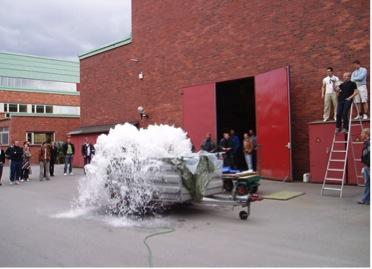Visa version
Visa
< föregående
|
nästa >
Jämför
< föregående
|
nästa >
1.3.5 A market-modified flood pump for a changing world
1.3.5 A market-modified flood pump for a changing world
Due to ongoing changes in climate, the risk for flooding has increased dramatically around the world – leading to a challenge defined by a pump company. The globally-operating Swedish pump company, formerly known as ITT Flygt and now called Xylem Water Solutions, wanted to increase its product portfolio by adding a competitive flood pump solution, and contacted KTH. A large group of students from KTH developed a submersible flood pump together with the company. The group also helped the company to analyse the market for flood pumps, so that the prototype could be designed to suit future customer needs. For more than six months 16 students worked together with four of the company's employees to investigate market opportunities and design a prototype for a pump.

Flood pump (120 litres/s) developed by students, Integrated Product Development.
Prior to the start of the project the company was already a world-leader in submersible pumps. But the company didn't have a pump optimised for flood situations in its product catalogue and knew too little about the requirements of potential customers; what would the customer want and how would the customer gain access to the pumps? Flood pumps are special in that they do not need to pump water over a considerable height. In many instances it is sufficient to pump over a height difference of around half a metre.
The pumps must also be able to be moved into place very quickly when they are needed. Therefore they must be available already before the flooding occurs, perhaps placed in a store cupboard or shed. They must also be sufficiently small to be able to be carried to and lowered into a drain. Finally the pump must have the capacity to pump very dirty water at high speed without breaking down.
The students were divided into two groups, with one group responsible for market analysis and one group responsible for design. The market analysis group interviewed different stakeholders to investigate who would be the potential customer, for example insurance companies, municipalities, government agencies, emergency services and companies offering complete pumping solutions.
The students concluded that the pump has a global market. This is due in part to an increase in flooding worldwide. The market analysis group put forward three proposals for how Flygt could reach the global market. One option is to sell pumps and another option is to lease pumps. The final option is to offer the pumps, pump operating personnel and maintenance as a complete “package solution”.
The design group constructed the flood pump, together with employees of ITT Flygt. The design was based on performance requirements, easy of handling and reliability. The pump needed to have the capacity to be able to pump at a speed of around 100 litres per second. It also had to be easy to take apart and put together, and had to weigh less than 50 kg. These are stringent requirements to fulfil but the students succeeded in the end - and by a good margin.
As part of the project presentation the students demonstrated the pump by using it to empty a 1500 litre tank that was filled with water. The 36 kg pump prototype emptied the tank with a spectacular flow at a maximum speed of 120 litres per second – mission accomplished!